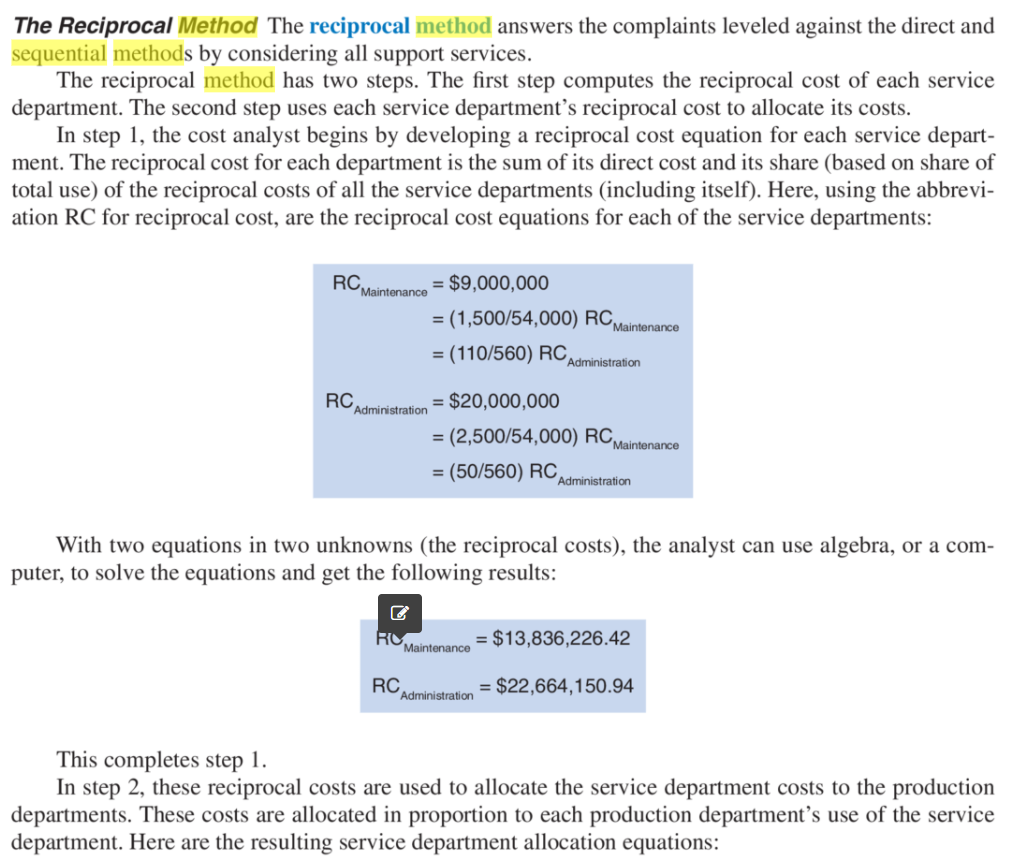The Reciprocal Method The reciprocal method answers the complaints leveled against the direct and sequential methods by considering all support services. The reciprocal method has two steps. The first step computes the reciprocal cost of each service department. The second step uses each service department's reciprocal cost to allocate its costs. In step 1, the cost analyst begins by developing a reciprocal cost equation for each service depart- ment. The reciprocal cost for each department is the sum of its direct cost and its share (based on share of total use) of the reciprocal costs of all the service departments (including itself). Here, using the abbrevi- ation RC for reciprocal cost, are the reciprocal cost equations for each of the service departments: RC, Maintenance = $9,000,000 = (1,500/54,000) RC, Maintenance = (110/560) RC, Administration RC Administration = $20,000,000 = (2,500/54,000) RC, Maintenance = (50/560) RC, Administration With two equations in two unknowns (the reciprocal costs), the analyst can use algebra, or a com- puter, to solve the equations and get the following results: RO Maintenance = $13,836,226.42 RC Administration = $22,664,150.94 This completes step 1. In step 2, these reciprocal costs are used to allocate the service department costs to the production departments. These costs are allocated in proportion to each production department's use of the service department. Here are the resulting service department allocation equations:
The Reciprocal Method The reciprocal method answers the complaints leveled against the direct and sequential methods by considering all support services. The reciprocal method has two steps. The first step computes the reciprocal cost of each service department. The second step uses each service department's reciprocal cost to allocate its costs. In step 1, the cost analyst begins by developing a reciprocal cost equation for each service depart- ment. The reciprocal cost for each department is the sum of its direct cost and its share (based on share of total use) of the reciprocal costs of all the service departments (including itself). Here, using the abbrevi- ation RC for reciprocal cost, are the reciprocal cost equations for each of the service departments: RC, Maintenance = $9,000,000 = (1,500/54,000) RC, Maintenance = (110/560) RC, Administration RC Administration = $20,000,000 = (2,500/54,000) RC, Maintenance = (50/560) RC, Administration With two equations in two unknowns (the reciprocal costs), the analyst can use algebra, or a com- puter, to solve the equations and get the following results: RO Maintenance = $13,836,226.42 RC Administration = $22,664,150.94 This completes step 1. In step 2, these reciprocal costs are used to allocate the service department costs to the production departments. These costs are allocated in proportion to each production department's use of the service department. Here are the resulting service department allocation equations:
Cornerstones of Cost Management (Cornerstones Series)
4th Edition
ISBN:9781305970663
Author:Don R. Hansen, Maryanne M. Mowen
Publisher:Don R. Hansen, Maryanne M. Mowen
Chapter7: Allocating Costs Of Support Departments And Joint Products
Section: Chapter Questions
Problem 5CE: Refer to Cornerstone Exercise 7.3. Now assume that Valron Company uses the reciprocal method to...
Related questions
Question
Sorry! I need the reciprocal method step.I need to be able to do this algebra equation

Transcribed Image Text:The Reciprocal Method The reciprocal method answers the complaints leveled against the direct and
sequential methods by considering all support services.
The reciprocal method has two steps. The first step computes the reciprocal cost of each service
department. The second step uses each service department's reciprocal cost to allocate its costs.
In step 1, the cost analyst begins by developing a reciprocal cost equation for each service depart-
ment. The reciprocal cost for each department is the sum of its direct cost and its share (based on share of
total use) of the reciprocal costs of all the service departments (including itself). Here, using the abbrevi-
ation RC for reciprocal cost, are the reciprocal cost equations for each of the service departments:
RC,
Maintenance
= $9,000,000
= (1,500/54,000) RC,
Maintenance
= (110/560) RC,
Administration
RC
Administration
= $20,000,000
= (2,500/54,000) RC,
Maintenance
= (50/560) RC,
Administration
With two equations in two unknowns (the reciprocal costs), the analyst can use algebra, or a com-
puter, to solve the equations and get the following results:
RO
Maintenance
= $13,836,226.42
RC
Administration
= $22,664,150.94
This completes step 1.
In step 2, these reciprocal costs are used to allocate the service department costs to the production
departments. These costs are allocated in proportion to each production department's use of the service
department. Here are the resulting service department allocation equations:

Expert Solution
This question has been solved!
Explore an expertly crafted, step-by-step solution for a thorough understanding of key concepts.
This is a popular solution!
Trending now
This is a popular solution!
Step by step
Solved in 2 steps with 5 images

Knowledge Booster
Learn more about
Need a deep-dive on the concept behind this application? Look no further. Learn more about this topic, accounting and related others by exploring similar questions and additional content below.Recommended textbooks for you

Cornerstones of Cost Management (Cornerstones Ser…
Accounting
ISBN:
9781305970663
Author:
Don R. Hansen, Maryanne M. Mowen
Publisher:
Cengage Learning

Managerial Accounting
Accounting
ISBN:
9781337912020
Author:
Carl Warren, Ph.d. Cma William B. Tayler
Publisher:
South-Western College Pub

Principles of Cost Accounting
Accounting
ISBN:
9781305087408
Author:
Edward J. Vanderbeck, Maria R. Mitchell
Publisher:
Cengage Learning

Cornerstones of Cost Management (Cornerstones Ser…
Accounting
ISBN:
9781305970663
Author:
Don R. Hansen, Maryanne M. Mowen
Publisher:
Cengage Learning

Managerial Accounting
Accounting
ISBN:
9781337912020
Author:
Carl Warren, Ph.d. Cma William B. Tayler
Publisher:
South-Western College Pub

Principles of Cost Accounting
Accounting
ISBN:
9781305087408
Author:
Edward J. Vanderbeck, Maria R. Mitchell
Publisher:
Cengage Learning

Managerial Accounting: The Cornerstone of Busines…
Accounting
ISBN:
9781337115773
Author:
Maryanne M. Mowen, Don R. Hansen, Dan L. Heitger
Publisher:
Cengage Learning

Financial And Managerial Accounting
Accounting
ISBN:
9781337902663
Author:
WARREN, Carl S.
Publisher:
Cengage Learning,